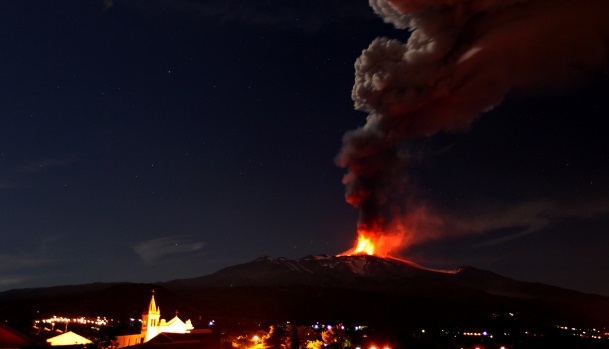Mount Etna is a composite volcano, comprised of numerous layers of solidified lava, pumice, tephra and ash and is the tallest active volcano in Europe, measuring close to 11,000 feet tall. Etna is in a state of almost perpetual activity, with one of the most recent eruptions - occurring Oct. 26, of this year - culminating in the closure of airspace around Sicily.
The Events Leading up to the Explosive Eruption
According to Volcano Discovery, which has been monitoring the tremor signals around Mount Etna for some time, the volcano has been demonstrating intermittent strombolian explosions from the southeast crater. Strombolian explosions are defined as relatively minor volcanic eruptions, hurling tephra, lava bombs and the pyroclastic material cinder several hundred meters into the air.
On Sunday Nov. 11, 2013, a series of strombolian explosions were evident from the southeast crater, as shown:
Many had speculated that, based upon the tremors and strombolian explosions witnessed throughout much of the past week, a paroxysm was likely. Paroxysms are characterized as the explosive phenomenon observed during an eruption, constituting the most dangerous and violent phase, where lava fountaining and emission is evident; the volatile event can also be accompanied alongside the release of reasonably large tephra columns.
A paroxysm was recorded on Nov. 11, generating a series of perfect smoke rings, but quickly died down by Wednesday, with a few low level tremors still detectable. Volcano Discovery explained the impact of the previous paroxysm on the lava flow of the southeast cone:
Increasing activity was noted during Wednesday afternoon, with two active vents sighted. Weak strombolian explosions persisted through the remainder of the week, until tremor activity began to rise on the Saturday, ominously signaling the arrival of another paroxysm."The latest paroxysm has greatly enlarged the field of young lava flows south of the SE cone, including the upper sections of the access road... The last recorded signal from the Torre del Filosofo seismic station (ETFI), showing the tremor intensity at unprecedented levels. If the eruption size is more or less proportional to the integral of the tremor amplitude, this illustrates the size of the paroxysm"
Mount Etna's Main Event
The main event took place around midnight and lasted for around five hours. Lava fountains spewed superheated material to heights of over 300 meters, sprinkling glowing lava over the darkened landscape. Lava flows were witnessed trickling down Mount Etna's peak, with a total of three flows.
However, based upon the latest tremor reports, it seems likely that another paroxysm could be imminent. The southeast crater continued to yield recurrent strombolian explosions in the aftermath of Sunday morning's breathtaking spectacle, in a similar vein to the previous paroxysm.

These types of eruptions are relatively common for Mount Etna, and a history of dangerous events were witnessed throughout the 20th century. In 1971, lava engulfed the Etna Observatory and endangered the lives of several nearby villages on the volcano's east flank. However, the longest eruption was yet to come; in 1979, the volcano produced a forceful eruption that lasted a duration of 13 years.
Similarly, the 1991 to 1993 eruption placed residents of the town of Zafferana at grave peril, until redirection efforts were coordinated by engineers; this resulted in the destruction of only a single building.
The Associated Press indicates that the latest violent eruption did not endanger any villages spread across the mountain slopes, and no evacuation order was necessary. However, the airport in the city of Catania, located on the east coast of Sicily, claims some airspace sectors have been closed off to flights.
The latest eruption represents the sixteenth paroxysmal explosion to have been documented in 2013. Mount Etna is a constant concern for local authorities, since a quarter of the island's population inhabits Etna's slopes. In addition, many of the residents rely upon the rich soils for agricultural purposes, stemming from past volcanic activity.




Reader Comments
to our Newsletter